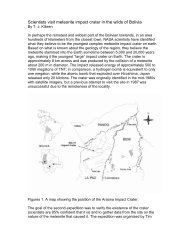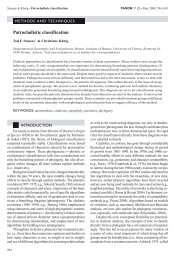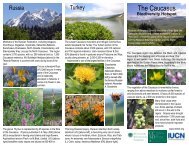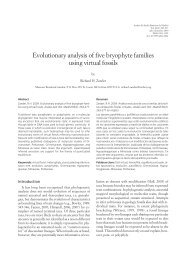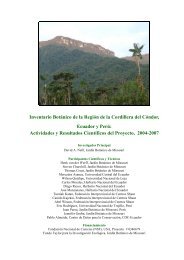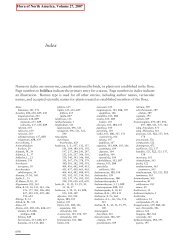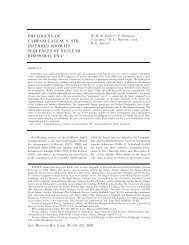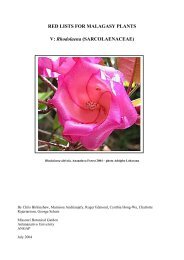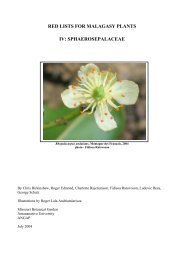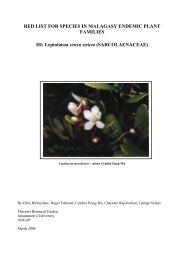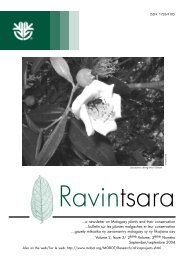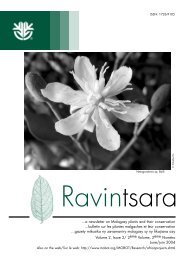re-evaluation of tortella - Missouri Botanical Garden
re-evaluation of tortella - Missouri Botanical Garden
re-evaluation of tortella - Missouri Botanical Garden
You also want an ePaper? Increase the reach of your titles
YUMPU automatically turns print PDFs into web optimized ePapers that Google loves.
Wash., W.Va., Wis.; Mexico, West Indies, South<br />
America, Europe, Asia, Africa, Pacific Islands.<br />
Herbaria examined: BUF, CANM, COLO,<br />
DUKE, FLAS, MICH, MNA, UBC.<br />
Although Tortella tortuosa is the most<br />
common <strong>of</strong> North American species <strong>of</strong> the genus in the<br />
North Temperate and Bo<strong>re</strong>al a<strong>re</strong>as by <strong>re</strong>p<strong>re</strong>sentation in<br />
herbaria, certainly T. humilis warrants this distinction in<br />
eastern middle-temperate and southern <strong>re</strong>gions. With<br />
few exceptions, all specimens examined we<strong>re</strong> fruiting.<br />
The species is so far known to be largely absent west <strong>of</strong><br />
the G<strong>re</strong>at Plains, including the Rocky Mountains and<br />
Basin and Range provinces. The<strong>re</strong> is a disjunctive<br />
population in British Columbia whe<strong>re</strong> it was collected<br />
once, while the southwestern range ends in Arizona.<br />
The species appears to be widesp<strong>re</strong>ad in the<br />
world but not cosmopolitan. Düll (1984), for example,<br />
indicated <strong>re</strong>ported locations throughout all <strong>of</strong> North and<br />
South America and Africa, Asia Minor and East Asia. It<br />
has a bipolar distribution and may be widesp<strong>re</strong>ad in the<br />
southern hemisphe<strong>re</strong> as well as the northern, however<br />
some caution is advisable due to the occur<strong>re</strong>nce <strong>of</strong><br />
similar taxa with diffe<strong>re</strong>nt sexuality (see discussion<br />
below). Certain absences <strong>of</strong> stations, or rarities seem<br />
curious, such as its absence from the British flora,<br />
although the climate the<strong>re</strong> dosen't seem to be an<br />
inhibiting factor when North American stations can be<br />
found as far north as Quebec. The species is virtually<br />
absent from Central Europe (Braunmiller et al. 1971;<br />
Düll & Meinunger 1989). In the former Soviet Union it<br />
is only <strong>re</strong>ported from European states and the Caucasus<br />
<strong>re</strong>gion, leaving the enti<strong>re</strong> eastern <strong>re</strong>gion without a<br />
<strong>re</strong>p<strong>re</strong>sentation (Ignatov & Afonina 1992).<br />
The epithet perhaps <strong>re</strong>fers to the short stem<br />
<strong>re</strong>sulting in a typically squat, rosulate rather than<br />
elongated habit that is mo<strong>re</strong> characteristic <strong>of</strong> other<br />
species in the genus. Tortella humilis is <strong>re</strong>cognized by<br />
its short stems with leaves in dense, stacked whorls in<br />
obscu<strong>re</strong> annual innovations subtended by tiny proximal<br />
leaves, by the <strong>re</strong>latively broad to occasionally narrowly<br />
acute, plane, non-cucullate to concave leaf apices, small<br />
and obscu<strong>re</strong> cells, and autoicous inflo<strong>re</strong>scences.<br />
In cross section, the costa diminishes in size<br />
toward the leaf tip: sectioning distally along the leaf, the<br />
epidermal layer first disappears, leaving up to two<br />
ste<strong>re</strong>id cells in width exposed. In some instances at the<br />
ext<strong>re</strong>me apex, even the ste<strong>re</strong>id layer disappears leaving<br />
the guide cells exposed. The apices <strong>of</strong> the leaves usually<br />
seem to twist at the apex so that one lamina lies flat and<br />
the other extends upwards. This is because one side <strong>of</strong><br />
the lamina is usually somewhat shorter than the other,<br />
with the shorter side angling toward the vertical.<br />
The leaves <strong>of</strong> Tortella humilis, together with<br />
those <strong>of</strong> unambiguous specimens <strong>of</strong> T. arctica, younger<br />
leaves <strong>of</strong> T. flavovi<strong>re</strong>ns and those <strong>of</strong> European T. nitida,<br />
a<strong>re</strong> notable by the gradual rather than abrupt transition<br />
<strong>of</strong> proximal cells to the distal laminal ones in addition to<br />
the marginal thin-walled cells that extend up the leaf<br />
margins, forming a U-shape to the proximal <strong>re</strong>gion,<br />
rather than the distinctive tortelloid V-shape. This<br />
6<br />
characteristic will permit easy confusion <strong>of</strong><br />
inf<strong>re</strong>quently sterile forms <strong>of</strong> Tortella humilis with<br />
Trichostomum tenuirost<strong>re</strong> (Hook. & Tayl.) Lindb. The<br />
well-developed peristome—elongate and conspicuously<br />
twisted—will distinguish Tortella humilis from<br />
specimens <strong>of</strong> T. flavovi<strong>re</strong>ns and Trichostomum species,<br />
whose peristomes a<strong>re</strong> either not or little twisted, or a<strong>re</strong><br />
rudimentary. Any specimen without fruit is unlikely to<br />
be Tortella humilis: if the<strong>re</strong> is no V-shape in any <strong>of</strong> the<br />
leaves on the stem, and if the<strong>re</strong> is the slightest hint <strong>of</strong><br />
marginal scalloping <strong>of</strong> the lamina and lamina fragility,<br />
the specimen is probably Trichostomum tenuirost<strong>re</strong>; if<br />
the sterile specimen occurs on coastal beaches in the<br />
southeastern United States, it is most likely Tortella<br />
flavovi<strong>re</strong>ns.<br />
In a<strong>re</strong>as whe<strong>re</strong> the ranges overlap, the leaves <strong>of</strong><br />
fertilized perichatia <strong>of</strong> the somewhat similar Tortella<br />
inclinata a<strong>re</strong> stiff, e<strong>re</strong>ct, narrowly lanceolate-subulate<br />
and have long-excur<strong>re</strong>nt costae, whe<strong>re</strong>as those <strong>of</strong> T.<br />
humilis a<strong>re</strong> little diffe<strong>re</strong>ntiated from the stem leaves.<br />
Tortella inclinata has a narrow groove <strong>of</strong> elongate,<br />
smooth-walled cells on the adaxial surface <strong>of</strong> the costa<br />
throughout the leaf and has no stem central strand,<br />
whe<strong>re</strong>as T. humilis has quadrate, papillose cells on the<br />
adaxial surface <strong>of</strong> the costa in the mid-leaf <strong>re</strong>gion and a<br />
well-developed central strand.<br />
Because the cells on the adaxial surface <strong>of</strong> the<br />
costa a<strong>re</strong> similar in shape and size to the laminal cells,<br />
and because the leaf base is <strong>of</strong>ten narrow (the leaf<br />
widest in the middle), and because the<strong>re</strong> is a stem<br />
central strand, the<strong>re</strong> is a superficial <strong>re</strong>semblance to<br />
Hyophila involuta (Hook.) Jaeg. & Sauerb.. This species<br />
typically differs by dentate leaf apices, horned<br />
propagula in the leaf axils and laminal cells in section<br />
bulging higher on the adaxial surface than the abaxial. It<br />
has no peristome nor does it fruit in our a<strong>re</strong>a. Plaubelia<br />
sp<strong>re</strong>ngelii (Schwaegr.) Zand., which is dioicous, lacks a<br />
well-developed adaxial ste<strong>re</strong>id band and has e<strong>re</strong>ct<br />
peristome teeth.<br />
Plants <strong>of</strong> Tortella humilis a<strong>re</strong> <strong>of</strong>ten confused<br />
with Barbula unguiculata Hedw., which differs most<br />
<strong>re</strong>adily in the <strong>re</strong>curvatu<strong>re</strong> <strong>of</strong> the proximal leaf margin<br />
and its dioicous condition. Crum and Anderson (1981)<br />
describe and illustrate the ra<strong>re</strong> species Trichostomum<br />
spirale Grout from the G<strong>re</strong>at Lakes <strong>re</strong>gion (Ontario,<br />
Wisconsin, Minnesota) that, like Tortella humilis, is a<br />
nearly stemless plant with gradually diffe<strong>re</strong>ntiated<br />
proximal cells and a similar leaf shape. It also has<br />
stalked perigonial buds and is autoicous, unlike the<br />
usual dioicous condition <strong>of</strong> the genus Trichostomum. It<br />
may be distinguished by the peristome teeth which a<strong>re</strong><br />
said to be short, e<strong>re</strong>ct and smooth or marked with spiral<br />
lines rather than spiculose papillae, the latter<br />
characteristic <strong>of</strong> peristomes <strong>of</strong> the genus Tortella.<br />
Two specimens seen from Mexico that<br />
conform to Tortella humilis (see Zander 1994d) in most<br />
<strong>re</strong>spects we<strong>re</strong> both autoicous and paroicous on the same<br />
stem, that is, they had stalked perigonial buds as well as<br />
robust antheridia in the axils <strong>of</strong> the distal stem leaves.<br />
Carl Müller (1878–79: 339–340) originally described





